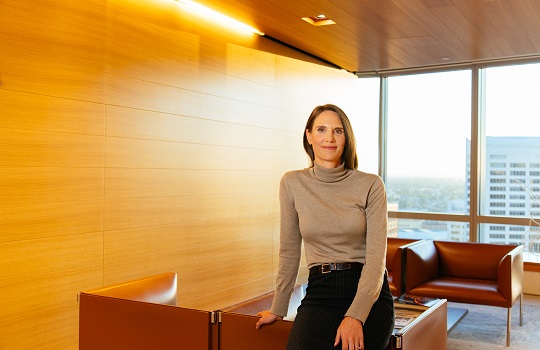
“Enhanced security is in the best interest of both customers and financial institutions. Our intent is never to hinder the client experience but to provide a safer corridor to perform a transaction.”
With Citi Australia doubling down on its commitment to digital-first banking, and in turn stepping away from their brick and mortar branches, technology has been thurst to the core of the company’s customer engagement strategy.
FST Media spoke with Tanya Smith, Citi’s chief customer officer, about the company’s assertive digital-first strategy, its considerable investment in APIs, and how its unique position as an ‘established challenger’ has given the multinational bank substantial leverage in Australia’s highly competitive, and digitally savvy, financial services market.
Tanya Smith will be a featured guest panellist at the 2018 Future of Financial Services conference in Sydney on the 8–9 November. Places are limited – secure your spot today!
————–
FST Media: Walk us through some of Citi’s digital priorities over the next 12 months.
Smith: Citi’s global strategy is to be an end-to-end digital bank – one that makes our services pervasive and beyond the constraints of traditional physical channels. Digital is the primary channel by which we acquire, service, and engage.
Locally, our priorities include leveraging data and analytical assets to increase personalisation and to drive a smoother customer journey. We are particularly excited about our efforts to enhance our mobile app, having just launched a user-friendly update that will improve the experience for our card customers. We also have a range of innovations in the pipeline, including allowing customers to pay for any transactions on points at the touch of a button, Apple Pay integration, and a smart global currency wallet.
FST Media: Does Citi embrace an early adopter or wait-and-see approach to digital innovation?
Smith: Australia is one of Citi’s most digitally engaged markets. 53 per cent of Citi Australia customers are digitally active with their banking, which compares to an Australia average of 41 per cent.
As a result, we know innovation is important to our clients and our advanced global digital network often allows us to be an early adopter locally. Some examples include launching mobile instalment plans, where customers can convert transactions or their full credit card balance to manageable instalment plans in a couple of clicks. Another example is our 2016 announcement to remove cash from our bank branches, as this service was being used by less than one in 20 customers, with 95 per cent of Citi Australia transactions occurring outside of branches.
However, in other instances, Citi does take a wait-and-see approach to ensure the innovation is something that our customers want. By taking this approach, we can also learn from and enhance the first-to-market innovation.
FST Media: What customer experience advantages do incumbent banks maintain over their fintech and challenger rivals? How can incumbents see off their rivals and maintain their superiority in CX?
Smith: Citi is in an interesting position of being a challenger locally, but also a global powerhouse. This means we can take advantage of the significant scale in our global network to ensure that we go above and beyond customer expectations. Our significant history and expertise also mean our customers trust in our experience, whereas the newer players still have to earn this trust.
While we are a big global player, we also like to learn from fintechs and challenger banks. Through Citi Fintech, we have a dedicated organisation that focuses on innovation, in particular mobile innovation and features. We also invest and partner with a number of fintechs to ensure we can stay in line with cutting-edge technology.
Since 2016, we have regionally launched partnerships with Alipay and WeChat in China (where over 80 per cent of our cards are now paid via Alipay in China); Line in Thailand, Grab, online retailer Lazada, and online accommodation rental platform Airbnb.
FST Media: How can security systems serve to enhance the customer experience rather than hinder it?
Smith: Enhanced security is in the best interest of both customers and financial institutions. Our intent is never to hinder the client experience but to provide a safer corridor to perform a transaction. Given that customers today are more aware of the external risks that can lead to potential fraud than ever before, we find they are more willing to adopt systems that provide more security.
Citi embraces various solutions like device print, anti-malware and risk-based authentication. These systems decrease the risk of fraud, help us correctly identify fraud, and reduce customer friction.
FST Media: Where do you see the limits of digitisation? Do you feel there is a customer experience that would be better left in the analogue world?
Smith: Australia is accelerating its efforts to transform its business from analogue to digital. We are seeing entire segments of our customers who not only want to deal with us digitally but are also disengaged if we can’t offer fully digital services.
Protecting our customers’ best interests is at the heart of our strategy, so with complex financial products, we are always balancing the simplification of features through a digital channel versus the need for flexibility, choice, and transparency that are often simpler to deliver in person-to-person interaction.
One example of balancing digital and analogue is our virtual relationship engagement tool we use in India. This allows our wealth management clients to communicate with their relationship manager via video chat. This means they maintain the same level of connection and can have the same in-depth conversations as if they were having an in-person discussion, with the convenience and accessibility of a digital system.
FST Media: What role can consumers play in shaping customer service platforms? Does Citi actively embrace a co-design philosophy for CX?
Smith: Including a customer in the process of design is extremely important; without them, you may find that what you are developing falls short of customer needs or expectations.
Recently, Citi launched a range of enhancements to its mobile app. This enhanced mobile experience was co-designed – from initially sourcing customer input on what their pain points and desired functionality with the app were to seeking feedback on the project during its development.
Taking a co-design approach ensures that we are setting customers up for success. Success from the customer’s perspective is the ultimate outcome and it builds a shared vision. Citi is currently exploring how a co-design philosophy could be integrated into our BAU systems.
FST Media: What would you consider Citi’s most daring digital innovation program within the last 18 months?
Smith: Citi’s digital growth has been underpinned by Citi’s investments in API (Application Programming Interfaces) capabilities, allowing us to leverage partnerships with relevant players – fintechs, start-ups, and established tech companies, for example – to develop and offer innovative solutions to customers more quickly and to significantly transform the customer experience globally.
Our impressive list of Australian partners now includes Qantas, Virgin Money, Coles, RACQ and Suncorp and BOQ.
Last year Citi launched a new global API developer portal in Singapore, Australia, and Hong Kong to connect with developers and enable them to build innovative client solutions faster. We are the first major bank to create a developer self-service global portal with access to a rich set of APIs.
FST Media: Citi has closed a number of their brick and mortar branches in Australia. What inspired this transition and has it borne fruit for the organisation?
Smith: Our customers are increasingly demanding a digital experience from us. While we have not removed all branches, Citi Australia announced in 2016 that it was removing cash from its Australian bank branches, as this service was being used by less than one in 20 customers. 95 per cent of Citi Australia transactions occurred outside of branches before this decision was made.
We see branches as having a role for more in-depth discussions for our high-net-worth clients – with a view to transitioning to a ‘wealth hub’ model. The nature of the Australian market and, in particular, its strengths in mobile banking and cashless transactions, allows us to leverage it to pilot initiatives in our business here that we then could roll out to other markets across the globe.
FST Media: What do you foresee as the definitive game-changing technology for financial services over the next two years?
Smith: The Open Banking regime has immense potential to shift control to the customer and allow them, through an application programming interface, to share the data on them that sits with their bank with another financial services provider, if they wish to explore changing banks or getting access to more innovative or relevant offers.
FST Media: As a panellist at the 2018 Future of Financial Services conference, Sydney, what insights are you hoping to take away from the stage?
Smith: Over the last 12 months, we have heard a lot about the decisions that banks have made and the impact this has had on their customers. As a Chief Customer Officer, I am interested in how our financial institutions of the future will genuinely put the customer at the centre of everything they do – every service they offer, every product they build. I believe if banks truly do put the customer at the very centre of their business models, we will see a really exciting shift in terms of regaining trust in banking.
————–
Tanya Smith will be a featured guest panellist at the 2018 Future of Financial Services conference in Sydney on the 8–9 November. Places are limited – secure your spot today!





